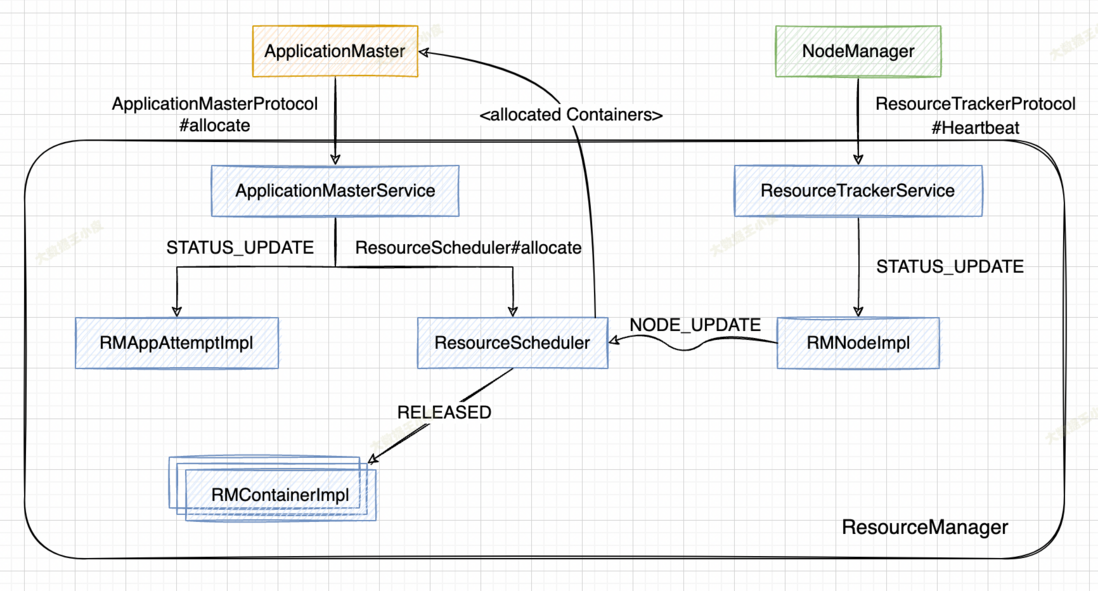本小节介绍应用程序的 ApplicationMaster 在 NodeManager 成功启动并向 ResourceManager 注册后,向 ResourceManager 请求资源(Container)到获取到资源的整个过程,以及 ResourceManager 内部涉及的主要工作流程。
一、整体流程
整个过程可看做以下两个阶段的送代循环:
- 阶段1 ApplicationMaster 汇报资源需求并领取已经分配到的资源;
- 阶段2 NodeManager 向 ResourceManager 汇报各个 Container 运行状态,如果 ResourceManager 发现它上面有空闲的资源,则进行一次资源分配,并将分配的资源保存到对应的 应用程序数据结构中,等待下次 ApplicationMaster 发送心跳信息时获取(即阶段1)。
一)AM 汇报心跳
1、ApplicationMaster 通过 RPC 函数 ApplicationMasterProtocol#allocate 向 ResourceManager 汇报资源需求(由于该函数被周期性调用,我们通常也称之为“心跳”),包括新的资源需求描述、待释放的 Container 列表、请求加入黑名单的节点列表、请求移除黑名单的节点列表等。
public AllocateResponse allocate(AllocateRequest request) {
// Send the status update to the appAttempt.
// 发送 RMAppAttemptEventType.STATUS_UPDATE 事件
this.rmContext.getDispatcher().getEventHandler().handle(
new RMAppAttemptStatusupdateEvent(appAttemptId, request.getProgress()));
// 从 am 心跳 AllocateRequest 中取出新的资源需求描述、待释放的 Container 列表、黑名单列表
List<ResourceRequest> ask = request.getAskList();
List<ContainerId> release = request.getReleaseList();
ResourceBlacklistRequest blacklistRequest = request.getResourceBlacklistRequest();
// 接下来会做一些检查(资源申请量、label、blacklist 等)
// 将资源申请分割(动态调整 container 资源量)
// Split Update Resource Requests into increase and decrease.
// No Exceptions are thrown here. All update errors are aggregated
// and returned to the AM.
List<UpdateContainerRequest> increaseResourceReqs = new ArrayList<>();
List<UpdateContainerRequest> decreaseResourceReqs = new ArrayList<>();
List<UpdateContainerError> updateContainerErrors =
RMServerUtils.validateAndSplitUpdateResourceRequests(rmContext,
request, maximumCapacity, increaseResourceReqs,
decreaseResourceReqs);
// 调用 ResourceScheduler#allocate 函数,将该 AM 资源需求汇报给 ResourceScheduler
// (实际是 Capacity、Fair、Fifo 等实际指定的 Scheduler 处理)
allocation =
this.rScheduler.allocate(appAttemptId, ask, release,
blacklistAdditions, blacklistRemovals,
increaseResourceReqs, decreaseResourceReqs);
}2、ResourceManager 中的 ApplicationMasterService#allocate 负责处理来自 AM 的心跳请求,收到该请求后,会发送一个 RMAppAttemptEventType.STATUS_UPDATE 事件,RMAppAttemptImpl 收到该事件后,将更新应用程序执行进度和 AMLivenessMonitor 中记录的应用程序最近更新时间。
3、调用 ResourceScheduler#allocate 函数,将该 AM 资源需求汇报给 ResourceScheduler,实际是 Capacity、Fair、Fifo 等实际指定的 Scheduler 处理。
以 CapacityScheduler#allocate 实现为例:
// CapacityScheduler#allocate
public Allocation allocate(ApplicationAttemptId applicationAttemptId,
List<ResourceRequest> ask, List<ContainerId> release,
List<String> blacklistAdditions, List<String> blacklistRemovals,
List<UpdateContainerRequest> increaseRequests,
List<UpdateContainerRequest> decreaseRequests) {
// Release containers
// 发送 RMContainerEventType.RELEASED
releaseContainers(release, application);
// update increase requests
LeafQueue updateDemandForQueue =
updateIncreaseRequests(increaseRequests, application);
// Decrease containers
decreaseContainers(decreaseRequests, application);
// Sanity check for new allocation requests
// 会将资源请求进行规范化,限制到最小和最大区间内,并且规范到最小增长量上
SchedulerUtils.normalizeRequests(
ask, getResourceCalculator(), getClusterResource(),
getMinimumResourceCapability(), getMaximumResourceCapability());
// Update application requests
// 将新的资源需求更新到对应的数据结构中
if (application.updateResourceRequests(ask)
&& (updateDemandForQueue == null)) {
updateDemandForQueue = (LeafQueue) application.getQueue();
}
// 获取已经为该应用程序分配的资源
allocation = application.getAllocation(getResourceCalculator(),
clusterResource, getMinimumResourceCapability());
return allocation;
}4、ResourceScheduler 首先读取待释放 Container 列表,向对应的 RMContainerImpl 发送 RMContainerEventType.RELEASED 类型事件,杀死正在运行的 Container;然后将新的资源需求更新到对应的数据结构中,之后获取已经为该应用程序分配的资源,并返回给 ApplicationMasterService。
二)NM 汇报心跳
1、NodeManager 将当前节点各种信息(container 状况、节点利用率、健康情况等)封装到 nodeStatus 中,再将标识节点的信息一起封装到 request 中,之后通过RPC 函数 ResourceTracker#nodeHeartbeat 向 ResourceManager 汇报这些状态。
// NodeStatusUpdaterImpl#startStatusUpdater
protected void startStatusUpdater() {
statusUpdaterRunnable = new Runnable() {
@Override
@SuppressWarnings("unchecked")
public void run() {
// ...
Set<NodeLabel> nodeLabelsForHeartbeat =
nodeLabelsHandler.getNodeLabelsForHeartbeat();
NodeStatus nodeStatus = getNodeStatus(lastHeartbeatID);
NodeHeartbeatRequest request =
NodeHeartbeatRequest.newInstance(nodeStatus,
NodeStatusUpdaterImpl.this.context
.getContainerTokenSecretManager().getCurrentKey(),
NodeStatusUpdaterImpl.this.context
.getNMTokenSecretManager().getCurrentKey(),
nodeLabelsForHeartbeat);
// 发送 nm 的心跳
response = resourceTracker.nodeHeartbeat(request);2、ResourceManager 中的 ResourceTrackerService 负责处理来自 NodeManager 的请 求,一旦收到该请求,会向 RMNodeImpl 发送一个 RMNodeEventType.STATUS_UPDATE 类型事件,而 RMNodelmpl 收到该事件后,将更新各个 Container 的运行状态,并进一步向 ResoutceScheduler 发送一个 SchedulerEventType.NODE_UPDATE 类型事件。
// ResourceTrackerService#nodeHeartbeat
public NodeHeartbeatResponse nodeHeartbeat(NodeHeartbeatRequest request)
throws YarnException, IOException {
NodeStatus remoteNodeStatus = request.getNodeStatus();
/**
* Here is the node heartbeat sequence...
* 1. Check if it's a valid (i.e. not excluded) node
* 2. Check if it's a registered node
* 3. Check if it's a 'fresh' heartbeat i.e. not duplicate heartbeat
* 4. Send healthStatus to RMNode
* 5. Update node's labels if distributed Node Labels configuration is enabled
*/
// 前 3 步都是各种检查,后面才是重点的逻辑
// Heartbeat response
NodeHeartbeatResponse nodeHeartBeatResponse =
YarnServerBuilderUtils.newNodeHeartbeatResponse(
getNextResponseId(lastNodeHeartbeatResponse.getResponseId()),
NodeAction.NORMAL, null, null, null, null, nextHeartBeatInterval);
// 这里会 set 待释放的 container、application 列表
// 思考:为何只有待释放的列表呢?分配的资源不返回么? - 分配的资源是和 AM 进行交互的
rmNode.setAndUpdateNodeHeartbeatResponse(nodeHeartBeatResponse);
populateKeys(request, nodeHeartBeatResponse);
ConcurrentMap<ApplicationId, ByteBuffer> systemCredentials =
rmContext.getSystemCredentialsForApps();
if (!systemCredentials.isEmpty()) {
nodeHeartBeatResponse.setSystemCredentialsForApps(systemCredentials);
}
// 4. Send status to RMNode, saving the latest response.
// 发送 RMNodeEventType.STATUS_UPDATE 事件
RMNodeStatusEvent nodeStatusEvent =
new RMNodeStatusEvent(nodeId, remoteNodeStatus);
if (request.getLogAggregationReportsForApps() != null
&& !request.getLogAggregationReportsForApps().isEmpty()) {
nodeStatusEvent.setLogAggregationReportsForApps(request
.getLogAggregationReportsForApps());
}
this.rmContext.getDispatcher().getEventHandler().handle(nodeStatusEvent);3、ResourceScheduler 收到事件后,如果该节点上有可分配的空闲资源,则会将这些资源分配给各个应用程序,而分配后的资源仅是记录到对应的数据结构中,等待 ApplicationMaster 下次通过心跳机制来领取。(资源分配的具体逻辑,将在后面介绍 Scheduler 的文章中详细讲解)。
三、总结
本篇分析了申请与分配 Container 的流程,主要分为两个阶段。
第一阶段由 AM 发起,通过心跳向 RM 发起资源请求。
第二阶段由 NM 发起,通过心跳向 RM 汇报资源使用情况。
之后就是,RM 根据 AM 资源请求以及 NM 剩余资源进行一次资源分配(具体分配逻辑将在后续文章中介绍),并将分配的资源通过下一次 AM 心跳返回给 AM。

**粗体** _斜体_ [链接](http://example.com) `代码` - 列表 > 引用。你还可以使用@来通知其他用户。